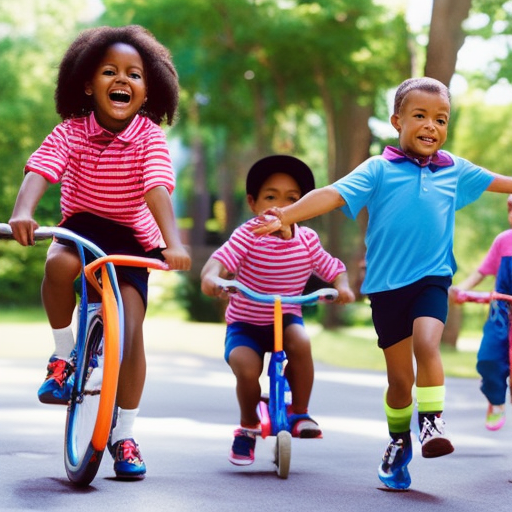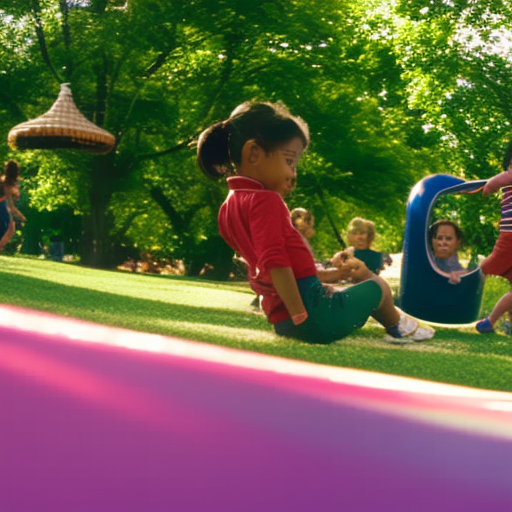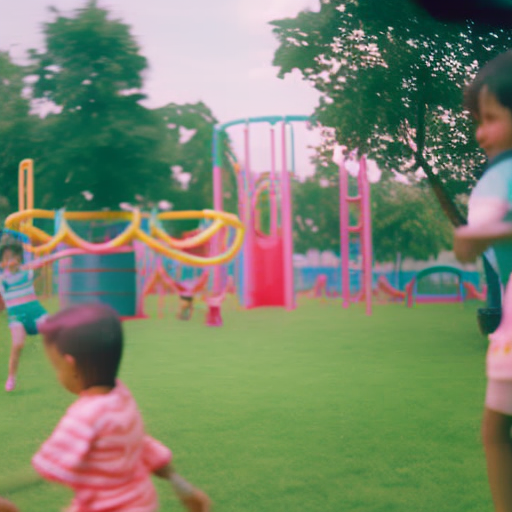"Cherishing Little Steps - A Haven for Baby and Family Journeys"
Promoting Physical Activity in Children
Hey there!
Are you looking for ways to get your little ones moving and grooving?
Well, promoting physical activity in children is like opening the door to a world of endless possibilities and potential. Just like how a butterfly emerges from its cocoon, physical activity helps children develop strength, coordination, and confidence. It lays the foundation for a healthy lifestyle and sets them up for success in the long run.
By incorporating age-appropriate activities, creating a supportive environment, and encouraging active playtime, you can help your child embrace the joy of movement.
So, let’s dive in and explore the ways we can make physical activity a part of their daily routine. Together, we can inspire a lifetime of health and happiness!
Key Takeaways
- Regular physical activity promotes overall well-being and active lifestyles in children.
- Engaging in physical activity reduces the risk of obesity and related health problems.
- Physical activity improves muscular strength, flexibility, and endurance.
- Regular exercise releases endorphins, reducing stress, anxiety, and symptoms of depression.
Importance of Physical Activity

You need to understand the importance of regular physical activity for children. Physical education plays a critical role in promoting active lifestyles and overall well-being in young individuals. Research has consistently shown that engaging in regular physical activity has numerous benefits for children’s physical, mental, and social development.
First and foremost, physical education helps children develop and maintain a healthy body weight. It reduces the risk of obesity and related health problems such as diabetes and cardiovascular diseases. Additionally, regular physical activity improves children’s muscular strength, flexibility, and endurance, enhancing their physical fitness and overall motor skills.
But physical education isn’t just about physical health. It also has a significant impact on children’s mental well-being. Regular exercise releases endorphins, which are natural mood-lifters, reducing stress, anxiety, and symptoms of depression. Moreover, physical activity has been linked to improved cognitive function, attention span, and academic performance in children.
Furthermore, physical education fosters social skills and teamwork among children. It provides opportunities for them to interact, cooperate, and compete in a positive and supportive environment. These experiences help children develop important life skills such as leadership, communication, and problem-solving.
Benefits of Regular Exercise

Regular exercise offers multiple benefits for your child’s physical, mental, and social well-being. Engaging in physical activity from a young age has long-term health benefits, setting the foundation for a lifetime of good health. It not only helps maintain a healthy weight and strengthens muscles and bones, but also reduces the risk of chronic diseases such as obesity, heart disease, and diabetes.
But the benefits of regular exercise go beyond just physical health. It also plays a crucial role in promoting your child’s mental and emotional well-being. Exercise has been shown to improve mood and reduce symptoms of anxiety and depression in children. It boosts self-esteem and confidence, enhances cognitive function, and improves concentration and academic performance.
To help you visualize the numerous benefits of regular exercise for your child, take a look at the table below:
| Physical Benefits | Mental and Emotional Benefits |
|---|---|
| Strengthens muscles and bones | Improved mood and reduced anxiety |
| Maintains a healthy weight | Boosts self-esteem and confidence |
| Reduces the risk of chronic diseases | Enhances cognitive function |
| Improves cardiovascular health | Improves concentration and academic performance |
Guidelines for Age-Appropriate Activities

When selecting age-appropriate activities for your child, it’s important to consider their individual capabilities and limitations. Age appropriate recommendations can help ensure that your child engages in activities that promote an active lifestyle while also keeping them safe.
For children aged 3 to 5, activities should focus on developing basic motor skills such as running, jumping, throwing, and kicking. Encourage active playtime, such as riding tricycles, playing tag, or participating in dance classes.
As children grow older, from ages 6 to 12, they can engage in more structured activities like organized sports, swimming, and biking. Encourage at least 60 minutes of moderate to vigorous physical activity each day, which can include activities like playing soccer, basketball, or even going for a brisk walk with friends or family.
Teenagers aged 13 to 17 should strive for at least 60 minutes of moderate to vigorous physical activity daily. Encourage activities that they enjoy and that can be sustained throughout their lives, such as team sports, dancing, or martial arts. Additionally, encourage strength-building exercises like push-ups, sit-ups, and weightlifting to help develop strong muscles and bones.
Creating a Supportive Environment

As your child engages in age-appropriate activities, it’s important to create a supportive environment that encourages and reinforces their participation in physical activity.
One way to do this is by cultivating a supportive community. Surrounding your child with friends, family, and neighbors who also prioritize physical activity can be incredibly beneficial. Encourage your child to join sports teams, clubs, or community groups where they can interact with peers who share their interests. This sense of belonging and camaraderie will motivate them to stay active and make physical activity a regular part of their lives.
Another important aspect of creating a supportive environment is promoting active transportation. Encourage your child to walk or bike to school instead of relying on cars or buses. This not only increases their daily physical activity but also helps them develop a sense of independence and self-reliance. Additionally, consider organizing walking or biking groups with other families in the neighborhood. This not only makes the journey more enjoyable but also provides a sense of safety and security.
By creating a supportive environment that values and promotes physical activity, you’re setting your child up for success. Remember, the habits they develop now will have a lasting impact on their health and well-being in the future.
Incorporating Physical Activity Into Daily Routine

To ensure that your child gets enough physical activity, incorporate regular bouts of exercise into their daily routine. One effective way to do this is by incorporating physical activity into the school curriculum. Many schools are recognizing the importance of physical activity and are incorporating it into their daily schedule. Physical education classes, recess breaks, and active learning strategies are all ways in which schools are promoting physical activity. By integrating physical activity into the school day, children are more likely to engage in regular exercise and develop lifelong healthy habits.
In addition to incorporating physical activity into the school curriculum, it’s also important to promote physical activity in urban environments. Urban areas often lack safe and accessible spaces for children to engage in physical activity. However, there are steps that can be taken to overcome these challenges. Creating safe walking or biking routes to school, establishing community parks or playgrounds, and promoting active transportation options are all ways to encourage physical activity in urban environments.
Making Exercise Fun and Engaging

To make exercise fun and engaging for your child, incorporate activities that they enjoy and can participate in with their peers. This won’t only make physical activity more enjoyable, but also encourage social interaction and teamwork.
Here are some fun activities and interactive games you can try:
-
Outdoor games:
-
Organize a game of tag or hide-and-seek in the park.
-
Set up an obstacle course with hula hoops, cones, and jump ropes.
-
Sports:
-
Enroll your child in a community sports league, such as soccer or basketball.
-
Have regular family sports nights where you play games like volleyball or badminton together.
By including activities that your child finds enjoyable, they’ll be more motivated to participate in physical activity. These fun and interactive games not only provide exercise, but also help develop important skills such as coordination, balance, and teamwork.
Remember to make it a positive experience by praising their efforts and creating a supportive environment. Additionally, involving their peers in these activities can make exercise even more enjoyable and help foster friendships.
Encouraging Active Playtime

- Incorporate at least three active playtime sessions into your child’s daily routine. Active playtime isn’t only essential for your child’s physical development but also for their overall well-being. By providing opportunities for outdoor exploration and building social skills, you can create a fun and engaging environment that encourages active play.
Outdoor exploration allows children to connect with nature, engage their senses, and develop their problem-solving skills. Take your child to local parks, nature trails, or even your own backyard. Let them run, jump, climb, and explore their surroundings. Encourage them to use their imagination, whether it’s pretending to be a pirate searching for treasure or a scientist discovering new species. Outdoor playtime not only keeps them active but also helps to reduce stress and improve their mood.
Building social skills is another important aspect of active playtime. Encourage your child to play with other children, whether it’s siblings, friends, or classmates. Engaging in group activities such as tag, hide-and-seek, or ball games helps them learn how to cooperate, communicate, and resolve conflicts. These social interactions are crucial for their emotional development and can help foster friendships and positive relationships.
Remember to keep the playtime sessions age-appropriate and enjoyable for your child. Incorporating active play into their daily routine sets the foundation for a healthy and active lifestyle. So, get outside, explore, and let the fun begin!
Promoting Sports and Team Activities

Incorporate sports and team activities into your child’s routine to further promote their physical activity and social development. Engaging in sports not only helps your child stay active but also teaches them valuable life skills such as teamwork, discipline, and perseverance.
Here are some reasons why promoting sports and team activities is beneficial for your child:
-
Team building: Participating in team sports allows your child to learn how to work collaboratively with others towards a common goal. They’ll develop skills like communication, cooperation, and problem-solving, all of which are essential for success in both personal and professional relationships.
-
Competitive spirit: Sports provide an opportunity for your child to experience healthy competition. This can help them develop a strong work ethic, resilience, and the ability to handle both success and failure. It teaches them the importance of setting goals, working hard, and pushing themselves to achieve their best.
Limiting Screen Time and Sedentary Behavior

Reduce the amount of sedentary behavior and screen time your child engages in to promote physical activity. In today’s digital age, it’s easy for children to spend hours sitting in front of screens, whether it’s watching TV, playing video games, or scrolling through social media. However, excessive screen time and sedentary behavior have detrimental effects on your child’s health and well-being.
Research shows that reducing screen time can lead to increased physical activity levels and the promotion of an active lifestyle.
By limiting screen time, you create opportunities for your child to engage in physical activities that promote their physical, mental, and social development. Encourage them to participate in outdoor games, ride a bike, or join a sports team. These activities not only provide exercise but also allow for social interaction and the development of important skills such as teamwork and problem-solving.
It is important to set clear limits on screen time and establish rules that prioritize physical activity. Create a schedule that includes designated screen-free times and encourage your child to engage in other activities during those times. Instead of using screens as a default option for entertainment, provide alternatives such as board games, puzzles, or arts and crafts that stimulate their creativity and keep them active.
Promoting an active lifestyle starts with reducing screen time and encouraging physical activity. By making small changes and setting clear boundaries, you can help your child develop healthy habits that will benefit them throughout their lives. Remember, it’s never too late to start promoting an active lifestyle for your child.
Role of Parents and Caregivers in Encouraging Physical Activity
Encourage your child’s physical activity by actively supporting and participating in their active endeavors. As a parent or caregiver, your role is crucial in promoting and maintaining your child’s physical well-being. Here are some ways you can play an active part in encouraging physical activity:
-
Lead by example: Children are more likely to engage in physical activity if they see their parents and caregivers being active. Show them the importance of an active lifestyle by participating in physical activities yourself.
-
Create opportunities: Provide your child with opportunities to be physically active. Encourage them to join sports teams, dance classes, or other physical activities they enjoy. Support their interests and help them find activities that suit their preferences.
-
Engage with schools: Schools play a significant role in promoting physical activity among children. Collaborate with teachers and administrators to ensure that physical education classes and recess time are given priority. Advocate for the inclusion of more physical activities in the curriculum.
-
Involve the community: Community involvement is essential in promoting physical activity for children. Encourage your child to participate in community sports events or join local clubs or organizations that promote physical fitness. This won’t only provide them with additional opportunities for physical activity but also foster social connections and a sense of belonging.
Frequently Asked Questions
How Can Physical Activity Benefit a Child’s Mental Health?
Regular physical activity has numerous benefits for your child’s mental health. It can improve mood, reduce symptoms of anxiety and depression, boost self-esteem, and enhance cognitive function. It plays a crucial role in their overall development and well-being.
Are There Any Specific Guidelines for Physical Activity for Children With Disabilities?
There are specific guidelines for physical activity for children with disabilities. Adaptive equipment and inclusive physical activities can help them stay active and enjoy the benefits of exercise, just like any other child.
What Are Some Creative Ways to Incorporate Physical Activity Into a Child’s Daily Routine?
You can easily incorporate physical activity into your child’s daily routine by engaging in outdoor games and encouraging active play indoors. These creative ways will keep them active and help promote a healthy lifestyle.
How Can Parents Encourage Physical Activity When Their Child Is Not Interested in Sports?
You can encourage physical activity in your child even if they’re not into sports. Try alternative activities like dancing or martial arts. Encourage outdoor play by going for walks or playing in the park.
What Are Some Strategies for Limiting Screen Time and Sedentary Behavior in Children?
You can limit screen time and sedentary behavior in children by encouraging outdoor activities and interactive games. Get them moving and having fun! It’s important for their health and development.
Conclusion
You hold the key to unlocking a world of physical activity for your child. Just like a gardener tends to their plants, nurturing them with care and attention, you have the power to cultivate a love for movement in your little one.
By providing a supportive environment, incorporating exercise into daily routines, and promoting active play and team activities, you can help your child blossom into a healthy and active individual.
So, grab that metaphorical watering can and let your child’s physical activity thrive!



deneme bonusu